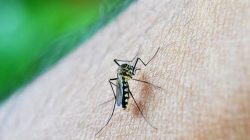The Crisis of Africa’s Freshwater Fish
A recent report by the World Wide Fund for Nature (WWF) has highlighted a growing crisis facing Africa’s freshwater fish species. The study, titled Africa’s Forgotten Fishes, reveals that one in four assessed species is now at risk of extinction. This alarming trend underscores the urgent need for action to protect these vital aquatic resources.
The report was released ahead of the Ramsar Convention on Wetlands COP15, an international conference focused on wetland conservation and management, which will be held in Zimbabwe later this month. Delegates from around the world are expected to use this platform to discuss strategies for restoring and preserving freshwater ecosystems across the continent.
According to the findings, 26% of the freshwater fish species evaluated in Africa are currently threatened, though experts believe the true number may be even higher due to limited data availability. Africa is home to over 3,200 freshwater fish species, with 28 new species discovered this year alone. This rich biodiversity highlights the importance of these species to both ecological and human systems.
Tanzania, along with Uganda, ranks among the top ten inland fish producers globally, largely due to Lake Victoria. This massive lake supports the livelihoods of millions, providing food, income, and cultural value to local communities. However, scientists warn that this critical resource is under increasing pressure from various threats, including pollution, overfishing, habitat destruction, and climate change.
Eric Oyare, the WWF Africa’s freshwater lead, emphasized the significance of Africa’s freshwater biodiversity. “Africa is not just rich in freshwater biodiversity; it’s also a hotspot for risk,” he said. He added that the loss of these species would have far-reaching consequences, impacting food security, income, cultural heritage, and natural climate resilience.
One of the most concerning findings from the report is the drastic decline in fish populations. In the Zambezi floodplain, some fish populations have dropped by as much as 90%, while Lake Malawi has seen a 94% decrease in its chambo tilapia—a species so important that it appears on the Malawian currency. These declines signal a broader ecological imbalance that could have serious implications for the region.
Freshwater fish play a crucial role in maintaining the health of rivers and lakes. As predators, herbivores, and nutrient recyclers, they help regulate aquatic ecosystems. Additionally, they are essential to the economies and diets of millions of people in rural Africa. In Tanzania, many communities rely heavily on fish as a primary source of protein and income, especially in regions like Mwanza, Kigoma, and Rukwa.
However, the future of these fish stocks is increasingly uncertain. Factors such as the use of illegal fishing gear, land degradation, and climate-related disruptions are threatening the sustainability of this vital resource. To address these challenges, the WWF has proposed a six-point Emergency Recovery Plan. This plan calls for actions such as restoring natural river flows, improving water quality, protecting critical habitats, and ending unsustainable fishing practices.
It also emphasizes the need to control invasive species and remove barriers that hinder the free flow of rivers. Conservation experts argue that effective solutions are within reach, citing successful community-led initiatives in Tanzania and neighboring countries. These models have shown promise by protecting breeding zones and promoting sustainable fishing practices.
Machaya Chomba, Africa Freshwater Manager at The Nature Conservancy, stressed the broader implications of losing freshwater fish. “The disappearance of freshwater fish is not just an environmental issue—it’s a direct threat to food security and cultural identity,” he said.
As the Ramsar COP15 conference approaches, the WWF is urging African nations, including Tanzania, to adopt the recovery plan and commit to global conservation frameworks. These include the Freshwater Challenge and the 30×30 target for inland waters under the Global Biodiversity Framework. The goal is to ensure that freshwater ecosystems are protected and restored for future generations.







